Marine Corps recruits participate in a combat conditioning course at Marine Corps Recruit Depot San Diego, March 10, 2021.
Providing up-to-date information, news and original content on American Military issues.
Marine Corps recruits participate in a combat conditioning course at Marine Corps Recruit Depot San Diego, March 10, 2021.
South Carolina National Guardsmen conduct site survey training to detect chemical threats and decontamination in Myrtle Beach, S.C., March 11, 2021.
Navy Petty Officer 2nd Class Javontae Kelley works as a tactical information coordinator during a ballistic missile defense scenario aboard the USS Curtis Wilbur in the East China Sea, March 15, 2021.
March 17, 2021 | BY Thomas Walsh , Military Health System
Referred to as 'MassVax,' the digital archive will accurately track and ensure that the DOD's patient population has received COVID-19 vaccinations, considered essential to both a ready medical force and medically ready force.
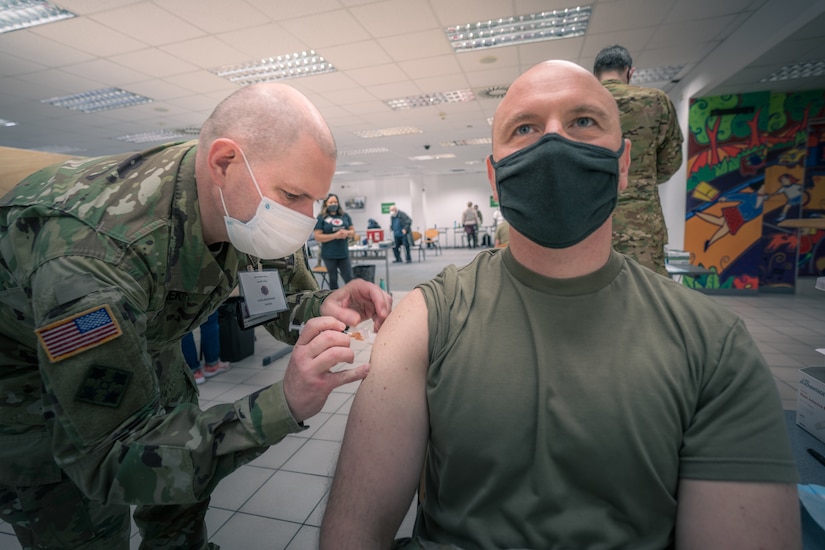
Air Force Col. (Dr.) Thomas Cantilina, chief health informatics officer for the Defense Health Agency, said the DOD partnered with Cerner Corp., the company that designed the still-evolving MHS GENESIS, to develop the new capability.
"MassVax is designed to help us quickly record who gave what vaccine, as well as when and where it was given," Cantilina said. "Additionally, and more importantly, MHS GENESIS and its MassVax capability have enhanced safety and efficiency at our COVID-19 vaccine sites, through its ability to provide clinicians with patient data related to drug and allergy interactions - prior to vaccines being administered."
There is plenty to keep track of. According to the Defense Department, as of March 5, 84% of vaccines received by the DOD have been administered, accounting for nearly 1.3 million total doses given at 335 sites; additionally, 81,256 vaccinations at retail pharmacies were administered to MHS beneficiaries. And the newly approved single-shot Janssen COVID-19 vaccine (also known as Johnson & Johnson) was being prepared for immediate DOD roll-out.
MassVax went live at Naval Hospital Twentynine Palms in California in September 2020, giving staff sufficient time to become proficient with the new system and recognize the powerful tool they had to administer vaccinations on a massive scale, touted Dave Marks, public affairs officer at NHTP. The facility supports the Marine Corps Air Ground Combat Center in the Mojave Desert, the largest Marine Corps base in the world.
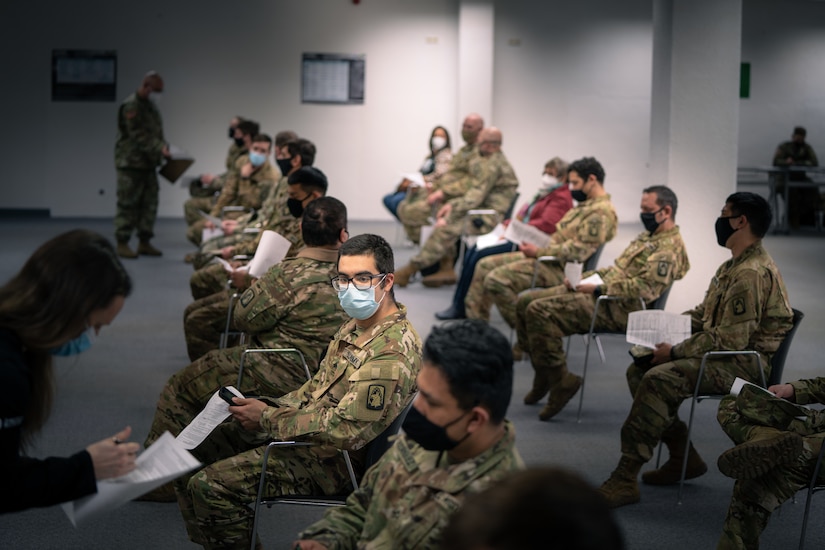
MassVax is speeding up the patient intake process by pre-populating registration data directly from a patient's electronic health record, or EHR, saving valuable time and allowing teams to focus on getting shots in arms, added Cantilina, who also serves as the Military Health System's deputy EHR functional champion. Patients have their identification cards scanned, rather than filling out traditional intake forms. Providers can quickly administer shots while scanning to record the exact moment a specific medication is given to a patient.
"As far as the post-pandemic use of MassVax is concerned, we not only plan on using it, but the capability was being developed for our use prior to the COVID-19 outbreak," he said. "In fact, our teams were particularly interested in using MassVax to facilitate the rapid administration of vaccines to troops preparing to deploy, as well as quickly administering vaccines to new recruits preparing for boot camp."
In its development cycle, MassVax is akin to the COVID-19 vaccines. The technologies to deliver similar products were in development long before March 2020 but were accelerated with additional resources set to respond to the pressing emergency of the deadly virus.
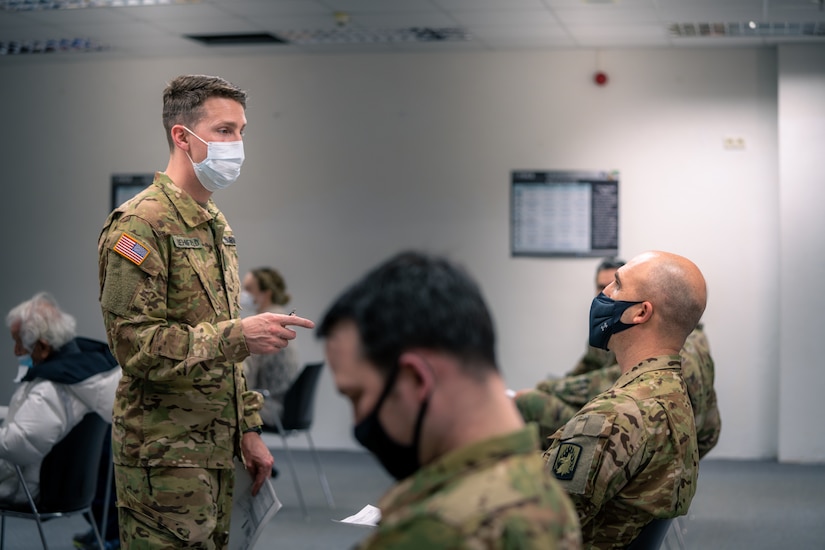
Cantilina explained that because of the pandemic, certain MHS GENESIS deployment activities that required staff to travel to support training efforts or facilitate new hardware and software installations were paused. But teams found ways to execute the mission of deploying MHS GENESIS while also mitigating the risk of contracting or spreading COVID-19, he added. MHS GENESIS is on track to be fully deployed by the end of 2023. At that point, the end state will be a single health record for all service members, veterans, and their families.
MHS GENESIS helps health care workers by "making it easy to do the right thing," Cantilina explained. Since it has been configured at an enterprise level, the system "leverages standardized workflows in each clinical area of practice, whether you're a doctor, nurse or technician. This simplifies how our providers care for patients as the system is designed to walk them through certain aspects of each patient encounter."
Cantilina again emphasized how the system alerts medical professionals of potential risks with each patient, like drug interactions or allergies.
Vasquez was involved in the years-long planning that led up to the implementation of MHS GENESIS, and she already had experience with the new system from her prior employment at a civilian hospital.
"I love it," she said. "I'm excited about having one military record for everyone. And I love that there's a patient portal available, especially since a lot of our families travel, and it's great for them to have access to their vaccination records and their actual patient history anywhere they go. It's amazing."
The 109th Airlift Wing began administering COVID-19 vaccines in Scotia, N.Y., March 10, 2021. The vaccines are available to New York Army and Air National Guard members.
Marine Corps 2nd Lt. Riley Compton flips a tire Marine Corps Base Camp Pendleton, Calif., Feb. 11, 2021.
Army 2nd Lt. Sharice Jones, an active-duty medical surgical nurse, assigned to the Brooke Army Medical Center, Fort Sam Houston, Tx.; Army 1st Lt. Erin Adelmann, an active-duty medical oncology nurse assigned to Walter Reed National Military Medical Center, Bethesda, Md.; and Army 1st Lt. Abigail Santora, an active-duty medical surgical nurse assigned to the Carl R. Darnall Army Medical Center, Fort Hood, Tx., prepare doses of the COVID-19 vaccine at the Fair Park Community Vaccination Center in Dallas, Tx., March 8, 2021. U.S. Northern Command, through U.S. Army North, remains committed to providing continued, flexible Defense Department support to the Federal Emergency Management Agency as part of the whole-of-government response to COVID-19.
Soldiers participate in a live-fire exercise during Eagle Sokol at Pocek Range in Postojna, Slovenia, March 16, 2021. The bilateral training exercise with the Slovenian Armed Forces builds teamwork and readiness between NATO allies.
Marine Corps recruits take on the Slide for Life obstacle on a confidence course at Marine Corps Recruit Depot San Diego, March 9, 2021.
March 17, 2021 | BY Jim Garamone , DOD News
The alliance was signed in 1953. South Korea had endured invasion and combat on its soil with millions of its citizens killed.
The United States as part of the United Nations effort came to the aid of the nation. The peace and security that followed the armistice enabled the Republic of Korea to rebuild its nation and forge ahead to become a democracy and an economic powerhouse.
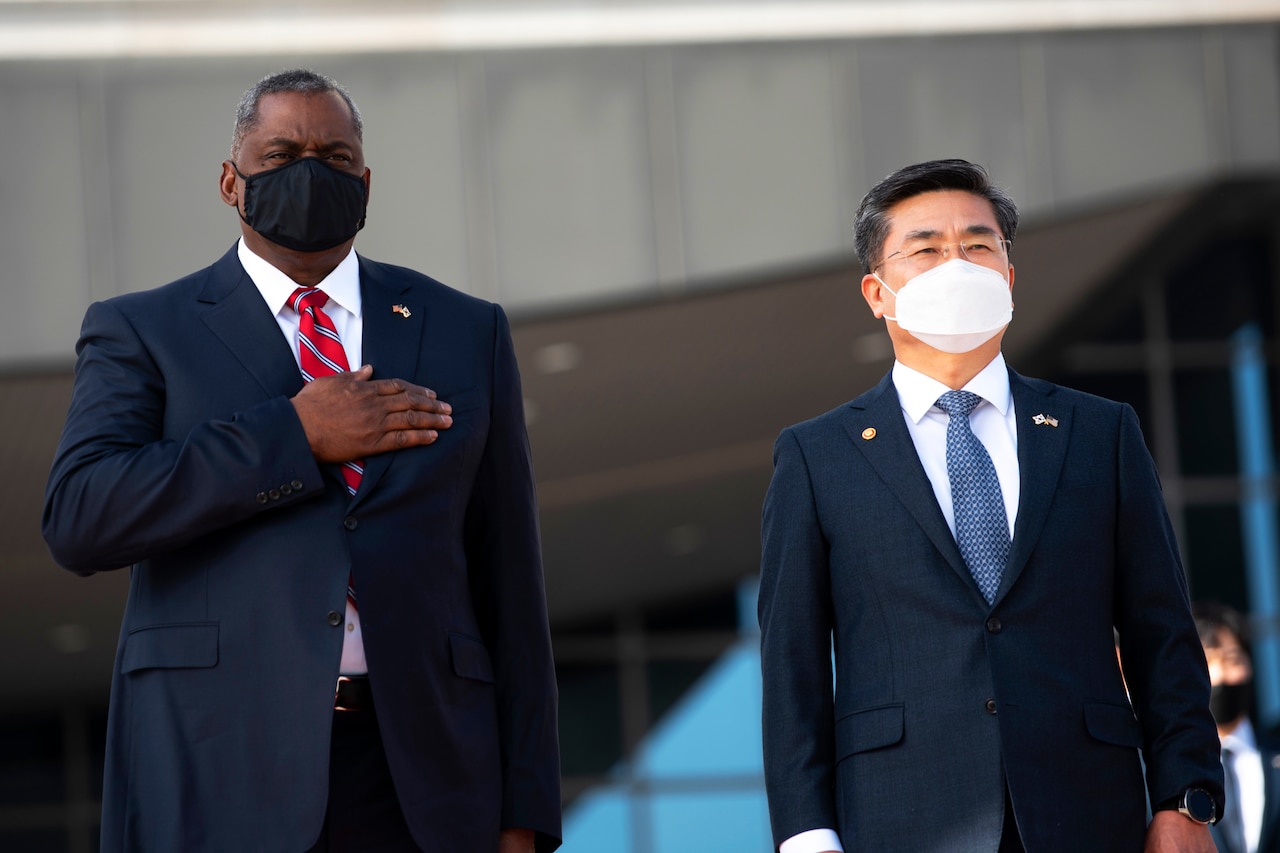
Austin said South Korea is "the linchpin" of peace, security and prosperity for Northeast Asia. "Our alliance is founded on shared interest and values and is among the most combined, interoperable, capable and dynamic bilateral alliances in the world," he said at the beginning of the meeting. "The ROK is also a critical partner for our shared priorities in the region. The principle among them is upholding the rules-based international order. You have become a key provider of security and stability in the Indo-Pacific region, and for that we are grateful."
The two defense leaders met on the eve of a larger meeting called the "Two-plus-Two" with Austin and Suh being joined by Secretary of State Antony J. Blinken and Minister of Foreign Affairs Chung Eui-yong. It is a measure of the importance of the region and the friendship between the two countries that these meetings take on added significance, said a senior defense official. This is the first official overseas trip by both Blinken and Austin.
Today's meeting concentrated on the military portion of the alliance. The two leaders reviewed the situation with North Korea, including the threat posed by North Korea's nuclear and missile programs, said the senior defense official. Both men agreed that this threat requires the continued vigilance of the alliance.
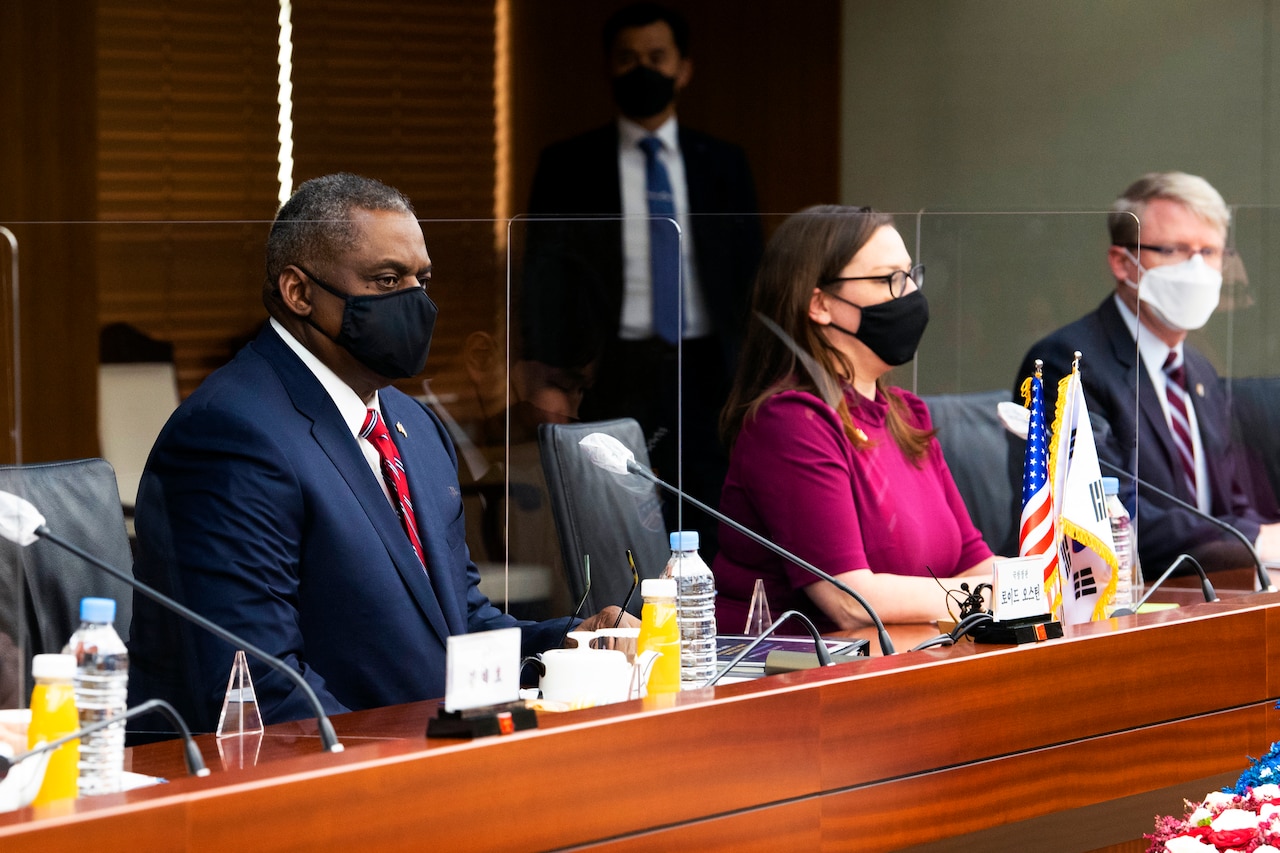
The alliance grew out of the Korean War and in the initial part of its history, was almost totally focused on deterring North Korea. While North Korea remains a threat, as South Korea rebuilt and became a regional power, the focus of the alliance has expanded to include the region. The two leaders spoke about the regional security environment beyond the Korean peninsula. These included China's actions to overturn the current rules-based system that has served the region so well since World War II, the official said.
This broader regional focus means increasing the contact and interaction between the US-South Korea Alliance and other like-minded partners. The defense leaders spoke about the trilateral relationship among the United States, South Korea and Japan. They also spoke about cooperation with nations such as Australia, India, Malaysia and others. Engaging in multilateral relationships would allow the nations of the region to build a network dedicated to supporting the rule-based system in the Indo-Pacific, the official said.
Austin also spoke frankly with his South Korean counterpart about the administration's Korean policy review. He wanted to consult with Suh because the secretary wants to get his observations, thoughts and input into that process.
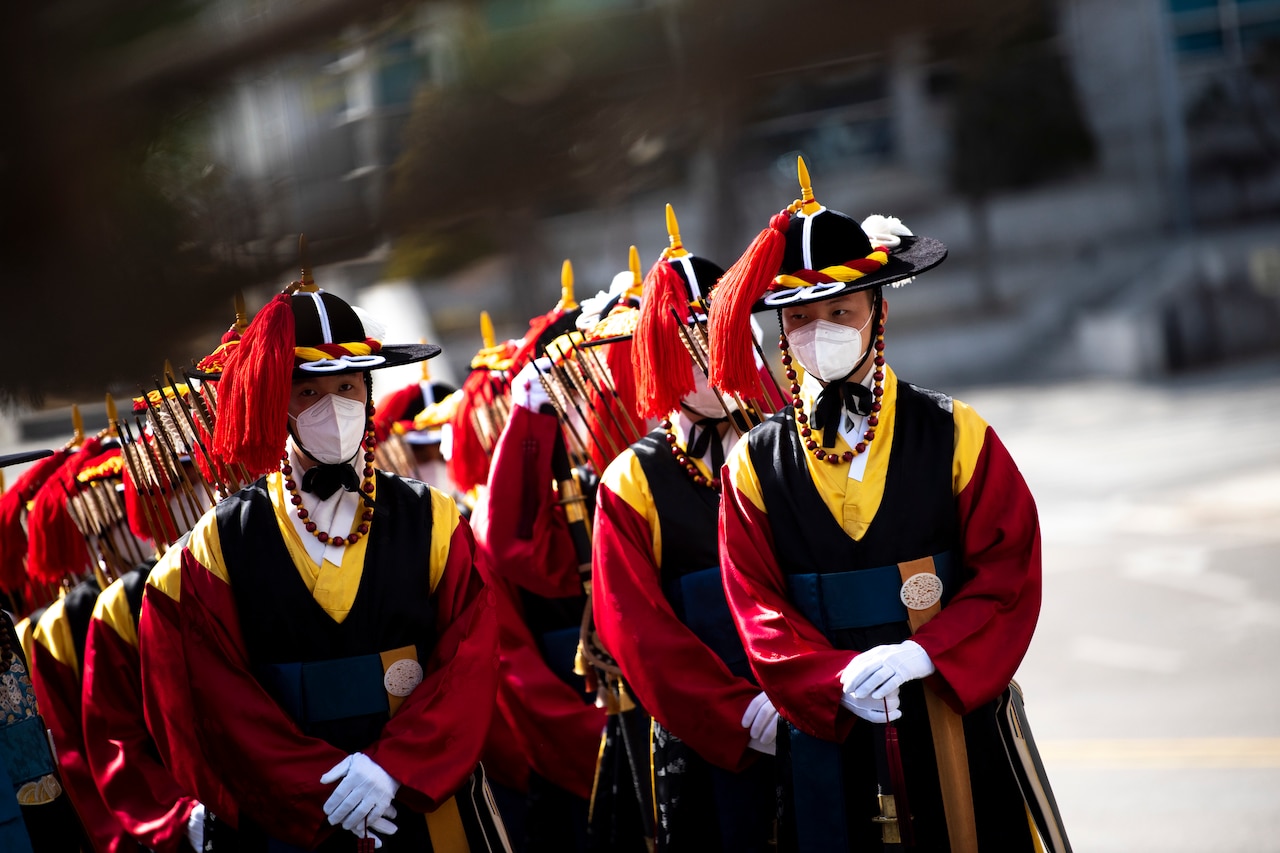
The two men discussed the readiness of the forces in South Korea especially in light of the COVID-19 pandemic. They discussed ways to increase readiness overall, and looked at the exercise program.
The North Korean border is just miles from the heart of Seoul. Long-range artillery, alone, could reach this vibrant city of 10 million.
There are 28,000 American service members assigned in South Korea ready to help that country "fight tonight" if need be. There are many, many more on call, if the North tries to duplicate 1950.
March 17, 2021
DEFENSE MINISTER SUH WOOK (THROUGH TRANSLATOR): First, I would like to extend my warmest welcome to Secretary Austin and the U.S. delegation on your visit to the Republic of Korea. Despite the busy schedule and challenging circumstances including the COVID -19 pandemic. Along the same lines, I again express my congratulations on the successful launch of the Biden administration and becoming the 28th United States secretary of defense.
This meeting is the first of its kind of the ROK minister of national defense and the U.S. secretary of defense at the start of the Biden administration, and it's also our first in-person meeting after our phone conversation a few months ago following your swearing in.
In that phone conversation, I remember your mentioning that you wanted -- you wanted for us to meet soon and construct close, bilateral cooperation between the Republic of Korea and the United States. I thank you, Mr. Secretary, for following through on exactly those words in just over a couple months. I believe such a quick visit to the Republic of Korea by you, Secretary Austin, resulted from the high value the Biden administration placed on our ROK-U.S. alliance.
For the ROK – U.S. alliance, born in the fire of the Korean War seven decades ago, forged in the blood shed together by our forefathers, both Korean and American. Since then, the alliance has conquered this lynchpin of peace and stability for not only the Korean Peninsula, but also, Northeast Asia. Our alliance continues to develop in a mutually-reciprocal manner following the start of the Biden administration. Our bilateral coordination mechanisms have never been more robust, and will continue to be strengthened.
(Inaudible) paramount in the process of our alliance's development is the maintenance of combined defense posture, formidable deterrence against North Korea. Going forward, the ROK and the U.S. will continue to further strengthen our bonds in the military alliance. Furthermore, I am certain we'll continue to develop (inaudible), mutual complementary and future-oriented global alliance, expanding the horizons of our cooperation.
Mr. Secretary, due to the firm trust we built between you and me, and between the ROK minister of national defense and the U.S. Department of -- of Defense, I hope our great institutions will be able to contribute immensely with the Biden and the Moon Jae-in administrations to upgrade our alliance (inaudible).
I believe trust and cooperation are the core of the ROK-U.S. alliance's development. I hope today's meeting will be a great start for the meaningful development of our alliance following the launch of the Biden White House. At the same time, I also hope the ROK minister of national defense and the U.S. Department of Defense, based on our shared values and trust, will continue leading the way for reciprocal cooperation between our two countries.
One thing Secretary Austin and I have in common is that we both enjoyed long careers in the militaries of our respective nations. By the end of today's meeting I hope, and certainly look forward to sharing much more in common with Mr. Secretary in many more areas.
Again, my warmest welcome to Secretary Austin. Thank you very much.
SECRETARY OF DEFENSE LLOYD J. AUSTIN III: Minister Suh and distinguished Korean friends, I am honored to be here with you in Seoul. And at the outset, Mr. Suh, please convey my thanks to your wonderful troops, who -- who really provided a -- a tremendous show of professionalism for us upon our arrival. We are very impressed. They are marvelous.
And Minister Suh, thank you for your gracious hospitality during my first overseas trip as secretary of defense to the Republic of Korea. Our commitment to the U.S.-ROK alliance, which has been steadfast for seven -- over 70 years, remains ironclad, and it is the linchpin of peace, security and prosperity for Northeast Asia, a free and open Indo-Pacific region and across the world.
Our alliance is founded on shared interest and values. It is among the most combined interoperable, capable and dynamic bilateral alliances in the world. The ROK is also a critical partner for our shared priorities in the region. Principle among them is upholding the rules-based international order. You have become a key provider of security and stability in the Indo-Pacific region, and for that, we are grateful. Given the unprecedented challenges posed by both the Democratic People's Republic of Korea and China, the U.S.-ROK alliance has never been more important.
I am here today to reaffirm to the United States' commitment to the defense of the Republic of Korea. You and I can both agree that military readiness is a top priority, and our combined readiness must ensure that we are ready to fight tonight, if needed. And I look forward to discussing a range of strategic and operational issues that will prepare our alliance to address our shared challenges in the years ahead.
Tomorrow, I also look forward to the initialing of the new Special Measures Agreement. Now, this agreement reflects our president's commitment to reinvigorating and modernizing our democratic alliances around the world to advance our shared security and prosperity. The United States and the Republic of Korea have faced many challenges together over the past several decades. We have risen to the occasion each time, driven by our mission to ensure the security and stability and prosperity of the Korean Peninsula and the Indo-Pacific region. It is obvious that we still are. Since its establishment in 1953, the U.S.-ROK alliance has proven strong and durable in the face of shifting global dynamics. I am confident that we will remain focused on our mutual ironclad commitment to each other's security as we build upon our long-standing trust and friendship. We will continue to go together into the future. “Katchi Kapshida”
TRANSLATOR: We go together.
An Air Force B-1B Lancer sits on the flightline at Orland Air Force Station, Norway, March 14, 2021.